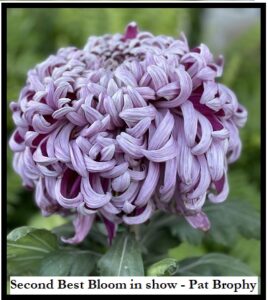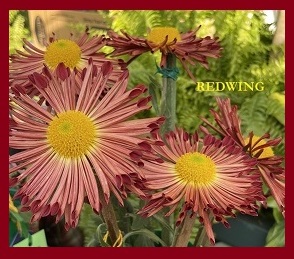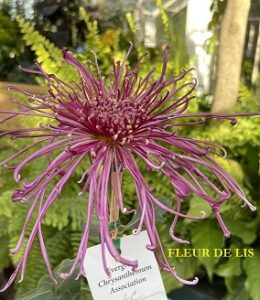Chrysanthemum Judging for ECA Show-2012 drs,10/05/12
Forward.
This document is a synopsis of NCS Judging rules combined with some parts of the Evergreen Chrysanthemum Association “Show rules”. It’s purpose is to provide both the judging teams and the show entrants a reliable reference on the aspects of quality and features of the various classes of Chrysanthemums. Additionally it contains some specific details on what chrysanthemum types can be entered into what sections in the show, supplementing the ECA show rules with data from the latest classification guides of the British NCS.
Preface
Per the Show rules:
1. All verities exhibited except for Section 33(American and other cultivars) must be named, registered classified and appear in the national Register of Chrysanthemums……… Or be listed in the ECA supplement of exceptions.
2. All plants must be grown by the exhibitor and competition is limited to amateur growers
3. All potted plants entered in competition must be a single plant to a pot, except section 32 (Cascades and Charms). All Tree form entries must be only 1 plant per pot.
4. To be eligible the entrant must be a paid up member of ECA as of May 1, year of show.
5. New members may exhibit as a novice for three years from the year of joining.
6. Judging will be conducted Under the National Chrysanthemum Society current code of Rules for Judging. These rules shall also apply to American and other non English varieties. However the American Chrysanthemum Society Rules for Judging may be consulted when questions arise as to form size and other characteristics
References:
1. National Chrysanthemum Society, Judging and Exhibiting, 2007 Revision
2. Chrysanthemum Judging and Exhibiting, Revised edition, published, Aug. 1998
3. Chrysanthemum Judging and Exhibiting, July, 1985
4. American Chrysanthemum Society Judging Rules, 1997 or later
5. Show Rules. Evergreen Chrysanthemum Association, Oct. 2011
Rules for Judging:
“The most meritorious Chrysanthemum bloom is one which displays form, size, freshness and color in accordance with that which is recognized as ideal for the particular type of cultivar.”
Form means approved shape of bloom as specified for the particular type at its most perfect stage of Development.
Size means a full sized specimen in keeping with the recognized normal full size for the cultivar. -Reduced size must always be penalized.
-Extra size is considered to be desirable, so long as the high standard of overall quality is
maintained. I view this as extra size could be of consideration as a tie breaker.
Freshness requires that florets should be unblemished and fresh to the tips. No damped off
Petals, no Aphids or other pests, and absence of any tired look.
Colour means that which is typical of a good colour for the cultivar.
-Reduced color must be penalized
-Color deeper than that which is normal must not be given preference
-Faint pink or green flush on some whites, and faint bronze flush on some yellows is
accepted as inherited characteristics and must not be penalized .
Uniformity between blooms of a particular cultivar, including size, form and color must always
be taken into account. But size varies between cultivars. Thus in mixed vases,
and multiple entries such as our challenges, balance is the concern rather than absolute uniformity of size.
Staging and Foliage must be taken into account in all cases
POINTS FOR CUT BLOOM ENTRIES:
Characteristic Points, sects. 1&2 Points, sects 3,4,5,6,7,10,…
Form 25 30
Size 30 20
Freshness 30 20
Colour 10 10
Staging and Foliage 5
Uniformity 10
Foliage 5
Staging 5
Total 100 100
Section 1 & 2 additional notes
-Blooms from cultivars in section 2(Mediums) cannot be shown in classes calling for section 1 blooms; and visa versa. However when a class calls for blooms of section 1 and/or section 2, both large and Medium blooms may be shown in the same class. Section 1 blooms being judged as large flowered and section 2 as medium flowered. For example, our Grand Challenge.
-Each bloom is judged against recognized size for that cultivar . Extra size is to be preferred where the desired high quality has been maintained.
-The incurving Bloom should be either closed on top or have a small area of young florets still to develop
-Many blooms in these classes still exhibit generally globular form, particularly the incurving varieties. However others tend to have rather different forms. such as Pear shaped etc. These are also acceptable when that general shape is adhered to.
-High quality blooms with extra depth relative to breadth are frequently encountered. This variation in form must be regarded as fundamentally equal to those of spherical form; but blooms lacking in depth relatively to breadth must always be down-pointed.
-Blooms that are markedly pointed at the crown must be down-pointed
-Reflexed blooms generally speaking should conform to the general standards, though in many cases there are acceptable and pleasing variations. Shoulders may be more angular, bottoms do not close in but are full floriated across the base. In some cases a few extra florets protruding below the base adds a pleasing dimension and are considered desirable, i.e. James Bryant.
-In all cases Symmetry should be of major consideration. When viewed from the top the bloom should be seen as round . When viewed from the side (any side) the bloom should be symmetric. At the bottom, closure should also be uniform.
Common Faults:
-Reduced Size (each bloom judged against the full size standard for that cultivar)
-Non Uniform shape
-Open (daisy) centers
-Non uniform lay of florets
-Untidy tops
-Gaps, creases, Wild florets etc.
-Damaged and damped off florets
-Mildew and damaged leafs, or no leafs at all
-Aphids and other bugs (Considered under the category of freshness)
-Depth less than height
Additional Notes, Incurves — sections 3,13 & 23
-Each bloom should be spherical in form. The crown should be neither pointed,
Flat, nor depressed. The base should not be flat nor elliptical due to presence of
long skirting florets.
-Florets should be smooth and free of barbs, dents or dimples. No tendency of
looseness at the base.
-Lay and density of the florets should be even throughout, no bulges, depressions,
steps or divisions.
-Florets may point toward the center of the crown, or they may whorl in one or
Both directions. In neither case should gaps or depressions be created.
-Color should be uniform throughout the bloom. Lower florets should be fresh and neither faded, discolored nor spotted. Whites and yellows in particular should be free of pinking.
Common Faults:
-Flat or depressed crown , flat base, conical shape when viewed from the side,
Elliptical outline when viewed from the side, pointed crown
-Daisy eye, centers elongated or doubled, florets loosely incurving, slightly
reflexed, dimpled , lumpiness, gaps in the outline, staleness, spotting.
-Blooms not at right angles to the stem.
Additional Notes-sections 4, 14 & 24
There are two main types of reflexed blooms:
-Fully reflexed with smooth shoulders
-Those with stiff, more spiky florets which do not form a smooth shoulder, but
Never the less develop in generally reflexing form .
– In either case blooms should be balanced in breadth and depth and circular as
viewed from above.
-Blooms Should have progressed to the 7/8 th stage of development. However if
blooms have reached the fully developed stage that is considered as equal to the
7/8th stage.
-Shoulders should be smooth, even and solid,
-At the base, the fully closed base, the flat/full base and the hollow base are
considered evenly acceptable so long as the bloom is fully reflexed
– Color should be uniform throughout the bloom except the young florets at the
Crown may be slightly deeper than the lower more mature florets.
Common Faults:
-Breadth without depth, Daisy eye or elongated centers, Lifting of florets along the shoulders, Uneven floret lay, Tiredness, Spotting or pinking, Damaged or damped off petals, Ragged surface appearance, Blooms not at right angles to the stems, Bumps and hollows and Aphids.
Additional Notes, Intermediates—Sections 5,15 & 25
Four distinct types can be listed
a) Loosely incurving bloom which closes at top
b) Loosely incurving bloom which doesn’t close at top
c) Tightly incurved bloom which doesn’t close at top
d) Bloom with upper florets incurving and lower florets reflexing
The a) Bloom is truly spherical when at peak development is it’s preferable form, though there is nothing to prevent it from being exhibited with a depressed crown(7/8th development) . But where such an intermediate has completely closed at the center and is as such close floret lay that it follows the characteristics of an incurve, it can be exhibited in an incurved class..
–Our ECA blooms, Harold Lawson and Stan Addison well fit this description.
The d) bloom–Some Intermediates have florets which fall in the manner of the reflex to show the inner color of the florets, while the upper florets remain incurved showing the reverse of the floret. With this type of bloom there should be a pleasant combination of colors and a smooth transition from one form to the other such that the bloom is globular when viewed from the side.
Common Faults:
Breadth without Depth, Daisy or Elongated centers, Uneven floret display, Lifted florets, Tiredness, Loose skirting, Blooms not at Right angles to stem, and Aphids.
Additional Notes, sections 6 thr0ugh 10
Anemones section 6 and 26:
– The cushion consisting of highly developed tubular disk florets as viewed from
the side should form an even portion of the outline of a sphere, but not more
than half of a sphere.
-The outline of the cushion as viewed from above should form a circle
-Cushion florets should be even in spacing , at their peak of development, and
fresh to the tips. –The center florets should not forma “dimple”
– The outline of the ray florets should be circular when viewed from above
– The ray florets may be broad ,flat, tubular or pointed. They may be even or
uneven in length, but should be regularly spaced.
-The ray florets should be at right angles to the stem.
Singles, Sections 7,17,& 27
A Single is so classified as having approximately 5 rows of ray florets. Some singles carry a row or two more than the stipulated ideal. Others may have less than 5 rows. All are treated similarly.
-Ray florets should be broad, flat and of even length.
-Ray florets should stand at right angles to the stem at their point of origin and maintain that direction through most of their length
– at the ends, the florets may continue flat to the tips, or Slightly reflex downward at the ends, or slightly reflex upwards at the ends. Where typical of the cultivar, all the variations are acceptable
-The disc should be circular, uniform in its construction and free from malformati0n or scars left by plucking of unwanted florets.
-In all Cases the outline of the tips should be circular when viewed from above.
Pompoms: Sections 8, 18 and 28
-True pompoms have florets of tubular type which build up into a fully globular shape.
-Semi-poms have similar tubular florets but are lacking in true spherical form and finish in the manner of a half sphere.
-In either case, blooms should be at the “seven-eighths” stage or a little further advanced in such fashion that a tiny central area of undeveloped florets is in evidence. Florets should be fresh, unmarked and of good color
Common Faults:
-Elongated or overfull centers, florets discolored at the base, blooms unevenly developed, blooms crowded on the stem.
Fantasies- -Spiders, Quills and Spoons: Section 10
Spiders, section 10a
-The florets of spiders are tubular, sometimes long and very fine, sometimes shorter and of greater substance. They may be tubular to the tip but in some cultivars the tips are open. In all cases the tips are hooked or coiled.
-Exhibition spiders should be double in form. Due to the tubular and often delicate construction of the florets, spiders are frequently reduced in substance relative to quills and spoons and the length of the mature florets is often in contrast to the younger florets near the crown never the less the development should be symmetrical and the blooms of any cultivar should be at a similar stage of development within an exhibit with a button or zone of young florets yet to unfurl.
-Common faults: Disc in evidence, elongated center, asymmetrical development,
Lacking in freshness, Absence if coils or hooks on some florets.
Quills, section 10b
-Florets should be tubular and either open at the tip or closed and pointed. Florets must be straight to the tip and free of hooks or coils. Blooms should be fully double with a button or zone of young florets yet to unfurl.
-The florets are generally less delicate and shorter than those of spiders. This
coupled with the straight florets makes for more globular and symmetric blooms.
-Common Faults:
Disc in evidence, Elongated centers, Asymmetrical development, Gaps in floret
lay, Lacking freshness, tips coiled or hooked.
Spoons: Section 10c:
-Spoons carry only a few rows of ray florets with the disc a prominent feature.
Ray florets should stand at right angles to the stem. They should be straight and
tubular to the greater part of their length with the tips opening in the manner of
a spoon.
-Ray florets may vary in length but in such a way that the bloom tips form an attractive pattern. In each case the circumference of the bloom should be circular in outline.
-The disc should be circular and free from wild petals, malformations and scars from removal of unwanted florets, Disc development should be uniform.
Common Faults:
Disc not circular, Florets not at right angles to the stem, Gaps, uneven spacing of florets, Cocked bloom, Outline of bloom not circular
Staging is essentially a multiple bloom entry problem that perplexes a lot of people. Here’s a few excerpts from the documents that should help clarify if not resolve all issues.
a) Blooms in a vase should be sufficiently spaced to facilitate their individual
examination and enjoyment, yet sufficiently close to ensure that the blooms
stand as a composite whole. “Points must be deducted where blooms are
touching or where they are too widely spread”
b) For 5 bloom vases some general guidelines are offered:
-The height of a central back bloom is first established in the region of 20” to 25”, with the 2
Flanking blooms an inch or so lower and the front 2 blooms an inch or so lower than that.
This is the standard display seen in British shows; however it is not a requirement and many
entries can be shown just as effectively with a nice circle of equal height blooms. Spiders for
instance sometimes stage very nicely in a relatively flat circlecircle.
c) Three blooms per vase were overlooked completely in the published staging rules.
However; 3 bloom entries usually follow the guideline of:
-One rear bloom at a height of 20-25 inches, with two front blooms 1-2 inches lower. Or else
– three blooms of equal height.
Additional notes derived from 2012 Publications
There are some reclassifications for 2012 and some proposed reclassifications. These include but are not limited to:
-Reclass, Mt. Shasta from section 1 to Section 2
-Reclass Kieth Luxford from section 2 to section 1
-Proposed Reclass: all Fairweathers, Reclass from section 3 to section 5
There are probably others we will have to pick up, but per the NCS rulings for 2012, all the reclassified and proposed reclassified cultivars can be shown in either their old and/or classification or both.
In addition we have an NCS exception rule that allows Connie Mayhew to be shown as either a #2 or a #5. And the new rules from the UK clearly allow certain #5s to be entered as #3s.
Another debarkation from what we have previously practiced concerns our Grand Challenge. Per the new rules, In classes where #1s and/or #2s can be exhibited, then the #1s will be judged against the rules for #1s and the #2s will be judged against the rules for #2s. Our past Judging for the Grand Challenge was that #2s could be included but they would be judged against the standards for #1s. I go along with this change.
Summary of entry variation Possibilities:
If you don’t plan to enter any blooms out of their listed classes in the Show catalogue you don’t have anything to worry about, but if you want to legally enter blooms outside their listed classification, consider this
-Only #1s can be entered in section 1 except for the Grand Challenge which
specifically calls for #1s and or #2s.
– Only #2’s can be entered in the #2 section with the exception of Connie Mayhew
Which per The ECA exceptions list can be shown as a #2.
– For section 3; #3s, #5s and #13s can be shown as #3s
-Section 4, show only #4s or #14s
-Section 5, Show only #5s or #15s
-Section 23, show only #13s and#23s
-section 24,show only #14s and #24s
I Hope this sheds new light what constitutes good blooms and exhibits and how they are to be judged; as well as guidance on what can be entered where in our coming 2012 show.
I’m always available to discuss these issues. Please call or email if any questions.
Good Luck, Don Stark 10/05/2012




